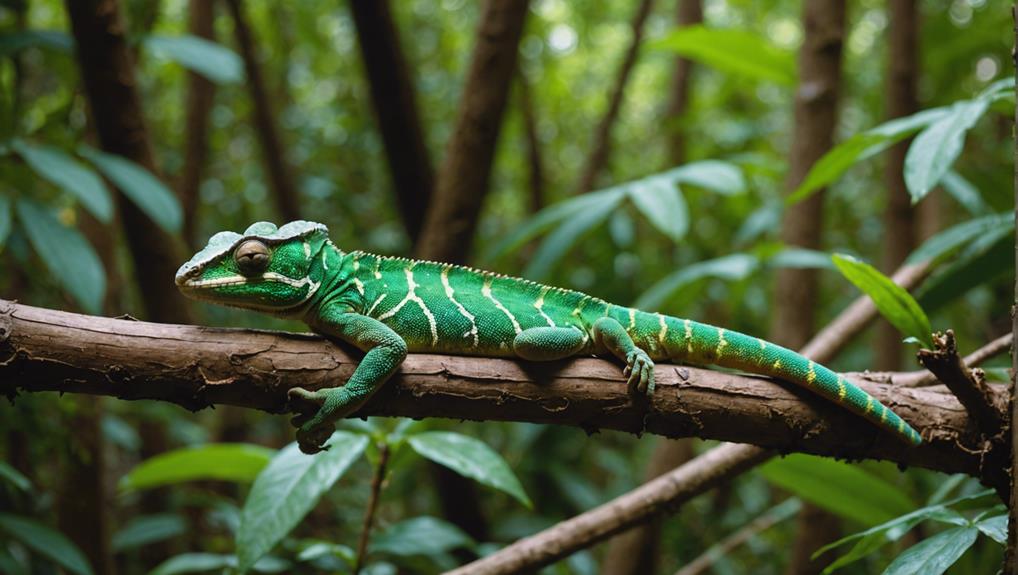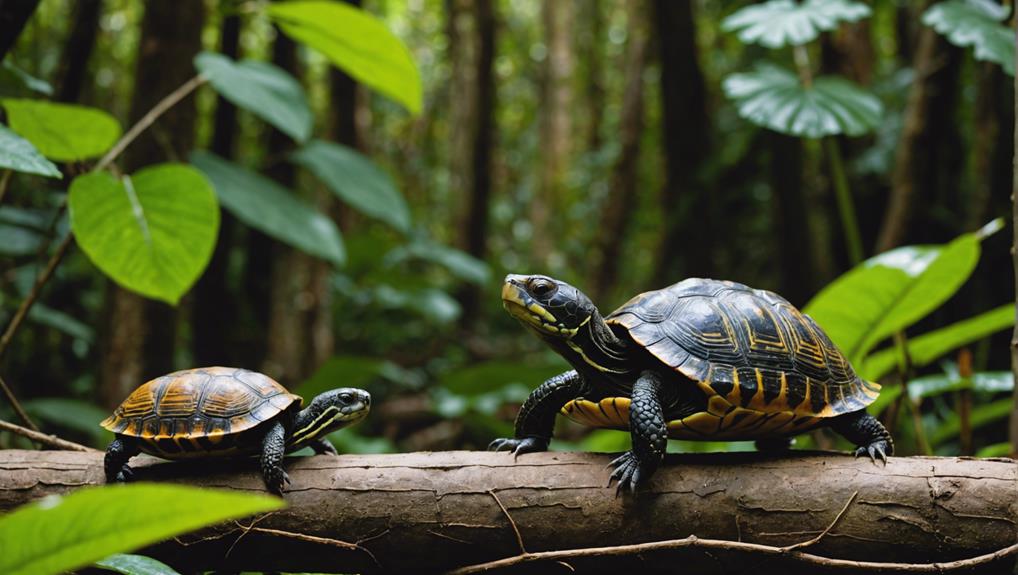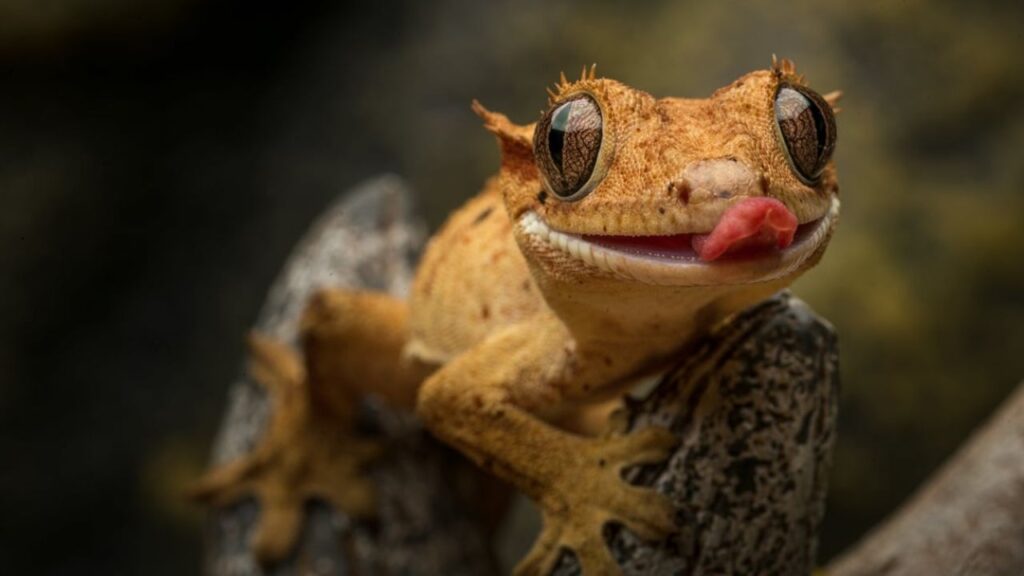Madagascar: A Reptile Paradise
Madagascar is home to a staggering array of reptile species, each uniquely adapted to the island's diverse habitats.
The island boasts over half of the world's chameleon species, including the vibrant Panther Chameleon and the impressive Parson's Chameleon.
Leaf-tailed geckos have mastered the art of camouflage, while snakes like the Malagasy tree boa and leaf-nosed snake display remarkable adaptations.
Tortoises and turtles, such as the Radiated Tortoise and Madagascar Big-headed Turtle, play critical ecological roles.
Despite their fascinating characteristics, these reptiles face significant threats from habitat destruction and poaching.
There's still much to be discovered about these remarkable creatures.
Unique Chameleons of Madagascar
Boasting vibrant colors and distinct features, Madagascar's chameleons are some of the most unique reptiles you'll ever encounter.
These fascinating creatures are known for their incredible ability to change colors, an adaptation that helps them communicate and camouflage. When you explore Madagascar, you'll notice that each chameleon species has its own set of patterns and hues, making every encounter a new discovery.
One of the most striking examples is the Panther Chameleon. This species showcases a spectrum of colors ranging from bright reds and blues to greens and yellows. You'll find them in the island's tropical forests, blending seamlessly with their surroundings while basking in the freedom of their natural habitat.
Madagascar is home to over half of the world's chameleon species, meaning you've got a good chance of spotting these elusive reptiles.
The Parson's Chameleon, one of the largest chameleons in the world, can grow up to 27 inches in length. Its majestic presence is hard to miss, especially when it's perched high in the treetops.
Chameleons possess zygodactylous feet, with two toes pointing forward and two backward, allowing them to grip branches securely.
Their eyes move independently, giving them a 360-degree view of their environment. This helps them stay alert and aware, essential traits for survival in the wild.
Leaf-Tailed Geckos
Shifting your focus from the vibrant chameleons, you'll find another group of remarkable reptiles in Madagascar: the enigmatic leaf-tailed geckos. These masters of disguise are a demonstration of nature's creativity, blending seamlessly into their surroundings. You might be fascinated to know that leaf-tailed geckos are named for their tails, which resemble leaves. This clever adaptation helps them evade predators and ambush prey.
You'll find several species of leaf-tailed geckos across Madagascar, each with its unique characteristics. Their flattened bodies, skin flaps, and mottled coloring allow them to mimic leaves, bark, or moss, making them almost invisible to the untrained eye. When exploring the rainforests, you'll need a keen eye and patience to spot these elusive creatures.
Their nocturnal habits mean they're most active at night, which is when they hunt insects and small invertebrates. If you venture out after dark, you might hear their soft chirps. While they're generally shy and reclusive, leaf-tailed geckos are also known for their defensive behaviors. When threatened, they may open their mouths wide to display a bright red or yellow interior, hoping to startle predators.
You'll appreciate that these geckos play a vital role in controlling insect populations, maintaining the delicate balance of their ecosystems. Their presence is a reminder of the intricate web of life that thrives in Madagascar. So, while you're immersed in the island's natural beauty, take a moment to appreciate the leaf-tailed geckos. They're a perfect example of adaptation and survival in the wild.
Snakes of the Island
Madagascar is home to a diverse array of snake species, each contributing to the island's unique ecosystem. You'll find a fascinating range of snakes here, from the harmless to the mildly venomous.
One of the most intriguing is the Malagasy tree boa. This non-venomous snake spends most of its time high in the trees, using its strong, muscular body to navigate branches and catch prey.
Another species you might encounter is the Madagascar ground boa. Unlike its tree-dwelling cousin, it prefers to stay closer to the ground where it hunts small mammals and birds. These snakes are constrictors, meaning they wrap around their prey and squeeze until the prey can't breathe.
You'll also come across the leaf-nosed snake, a master of disguise. It's named for its unique, leaf-shaped snout which helps it blend into its surroundings. This snake is mildly venomous, but its venom isn't dangerous to humans. It primarily uses its venom to immobilize small lizards and frogs.
For those who love to explore, the speckled hognose snake is a real treat. This burrowing snake has a distinctive upturned snout that it uses to dig through loose soil. It's a diurnal species, so you might spot it during the day as it hunts for insects and small vertebrates.
Madagascar's snakes, though often misunderstood, play vital roles in controlling pest populations and maintaining ecological balance. They offer a glimpse into the island's rich biodiversity and remind us of the intricate connections within nature. So, when you venture through Madagascar, take a moment to appreciate these slithering wonders of the wild.
Tortoises and Turtles
Among the fascinating reptiles in Madagascar, tortoises and turtles stand out for their unique adaptations and essential roles in the ecosystem.
You'll find species like the Radiated Tortoise and the Madagascar Big-headed Turtle, both remarkable in their own right. These creatures have evolved to thrive in Madagascar's distinct habitats, showcasing their incredible resilience and versatility.
The Radiated Tortoise, for example, is known for its striking shell, patterned with yellow lines radiating from the center of each scute. This tortoise roams the island's dry forests and scrublands, feeding on grasses, fruits, and succulent plants.
Its grazing helps maintain the balance of vegetation, preventing overgrowth and promoting biodiversity. As you might imagine, these tortoises play a pivotal role in their habitat's health.
In contrast, the Madagascar Big-headed Turtle prefers freshwater environments like rivers and lakes. Its broad head and powerful jaws allow it to feed on a variety of prey, including fish, insects, and crustaceans.
This turtle contributes to controlling aquatic populations, maintaining the ecosystem's balance. Watching these turtles swim gracefully can remind you of the interconnectedness of life in Madagascar's waterways.
Both these species are fascinating not just for their physical characteristics but also for their ecological significance. By keeping the environment in check, they help safeguard that Madagascar's diverse range of flora and fauna can flourish.
Whether you're trekking through a dry forest or kayaking in a serene river, encountering these unique reptiles highlights the island's incredible biodiversity and the key roles tortoises and turtles play in sustaining it.
Conservation Challenges
Despite their remarkable adaptations and roles in the ecosystem, tortoises and turtles in Madagascar face significant conservation challenges that threaten their survival.
Illegal poaching, habitat destruction, and the pet trade are major issues that put these unique reptiles at risk. Many species are captured and sold illegally, fetching high prices on the black market. This illegal activity decimates wild populations and disrupts the delicate balance of their natural habitats.
Habitat destruction is another pressing issue. Madagascar's forests are being cleared for agriculture, logging, and development. When these habitats are destroyed, tortoises and turtles lose their homes and food sources. They struggle to find new areas to live, which makes them more vulnerable to predators and environmental changes.
The pet trade also poses a significant threat. Exotic pet enthusiasts often seek out Madagascar's unique reptiles, leading to over-collection and further depletion of wild populations. Capturing these animals from the wild not only reduces their numbers but also stresses them, leading to lower survival rates in captivity.
Supporting conservation efforts can make a difference. Organizations are working to protect habitats, enforce anti-poaching laws, and raise awareness about the importance of preserving these species. By supporting these initiatives, you can help safeguard that Madagascar's tortoises and turtles continue to thrive in their natural environments. Every action counts, and your support can contribute to a brighter future for these incredible reptiles.
Conclusion
Madagascar's diverse reptile species, including unique chameleons, leaf-tailed geckos, various snakes, and tortoises, showcase the island's rich biodiversity.
However, these species face significant conservation challenges due to habitat loss and other threats.
It's vital for conservation efforts to focus on protecting these unique reptiles to maintain the ecological balance.
By learning about and supporting conservation programs, you can help safeguard that Madagascar's incredible reptile diversity is preserved for future generations.


